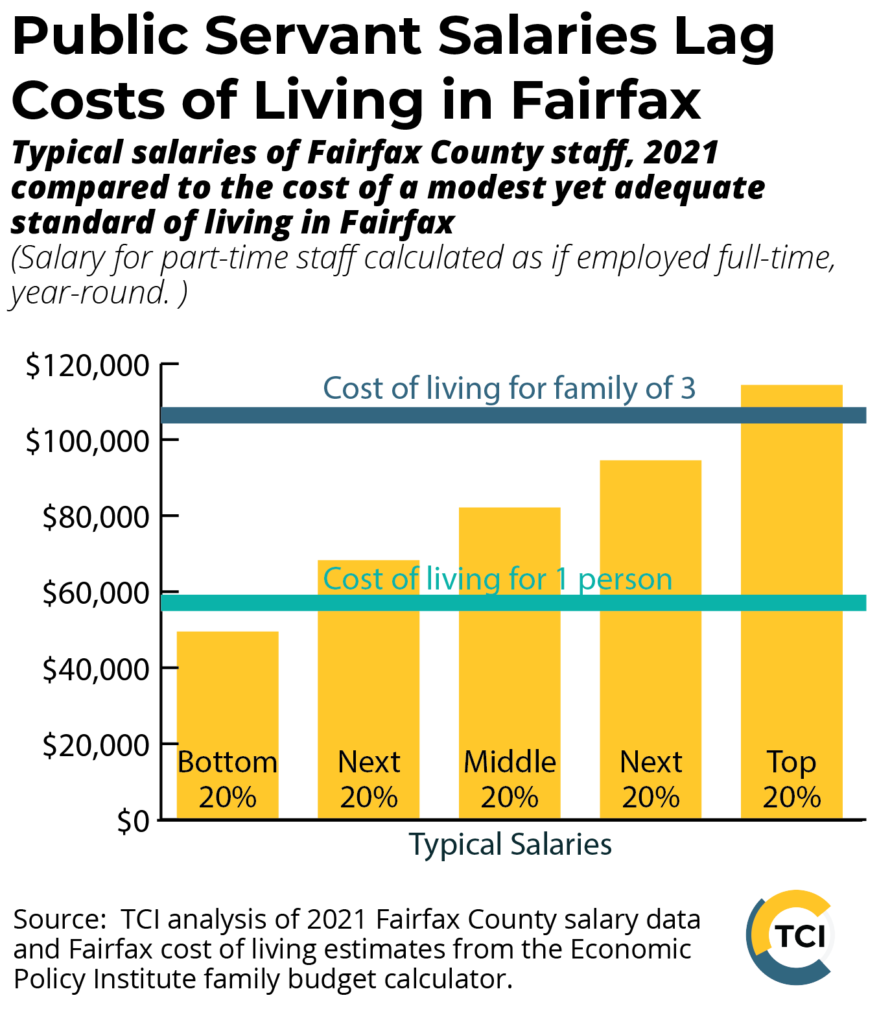July 21, 2021
Rebuilding Stronger for Fairfax County: Collective Bargaining Advances Equity and Strengthens Families
Fairfax County is a vibrant, diverse community where people choose to live and work together for better opportunities for all of us. Fairfax has top-notch public services, and that’s part of what makes our communities great. Fairfax’s public employees play a huge role in creating and maintaining those services, and it’s important that we make sure that those public servants are fairly paid and have a voice in their workplace. Allowing collective bargaining will allow county employees a formal voice to lift up ways to improve public services and build a more equitable workplace. In the end, that benefits every one of us.

“No matter the color of your skin or where you live, all county employees deserve to be treated fairly and with respect. As a Fairfax County employee of over 30 years, I know that having respect and equity in the workplace requires having a seat at the table. To truly have a strong voice and the power to win better jobs, we need to join together in our union and win collective bargaining rights.”
— Tammie Wondong, Fairfax President of SEIU Virginia 512 and Human Service Assistant, Department of Family Service
Public employees in Northern Virginia are currently underpaid and turnover rates are high

- Many local public employees in Fairfax County can’t afford to live in the county they serve. A review of county employee classifications and maximum hourly pay or salaries for those roles shows that one in seven Fairfax County employees couldn’t afford to support themselves on their salary in Fairfax County at a modest yet adequate standard of living. And the majority couldn’t attain an adequate standard of living on what they are paid if they have children.1
- Local public employees in Virginia are typically paid 29.9% less than their private-sector peers with similar levels of education, age, and hours worked, one of the largest pay penalties in the country. Although data is limited, it appears that the penalty is even larger in Northern Virginia, with local government employees being paid 33.4% less than their private-sector peers.2
- Pension and healthcare benefits don’t make up for these pay penalties. Employee benefits for local public employees in Virginia are less generous than in other parts of the country, and many private-sector employees, particularly full-time employees of large companies, receive generous benefits. For Virginia as a whole, the estimated total compensation penalty for local employees compared to their private-sector peers is 28.0%, close to the pay penalty of 29.9%.
- Turnover rates for county employees are high, which has direct costs in terms of training and recruitment, and also reduces the quality of services as fewer employees are stretched thin trying to do multiple jobs. In FY2016, position turnover and vacancies for Fairfax County employees equated to 8% of all positions, up from 3.4% in FY2007.3 One review of 30 case studies in 11 research papers found that turnover costs employers between 16% and 21% of an employee’s annual salary.4
Unions reduce unfair pay inequities
For public employees, one of the benefits of unions is increasing pay to levels that are closer to that which could be obtained in the private sector. Overall, public sector collective bargaining tends to boost pay by 5% to 8%,5 and the fair and clear standards provided by unionization particularly help Black and Latinx workers. Women, who make up the majority of local government workers (especially in Virginia), would also particularly benefit from collective bargaining. This is important because past discrimination and ongoing barriers mean Black workers, Latinx workers, and women of all races are still typically paid less than white men with the same level of education and experience in both public and private sector employment.

“Sadly, in an industry like childcare, where the majority of workers are women and people of color, the work and safety concerns of employees are often dismissed. Pay inequities and lack of benefits are basically ignored. All workers deserve to be respected, protected on the job, and paid a living wage. As a white man, I saw the level of privilege that was afforded to me and denied others, further perpetuating racial disparity and lowering the morale of some of the county’s most dedicated and skilled workers. The same issues can be found in other Fairfax County departments. We can and we must do better; for the sake of the county, its employees, and the diverse community we serve.”
— Norm Hall, Former Childcare Specialist, currently Administrative Assistant in Department of Transportation
While local employees in Virginia are typically paid 29.9% less than their private-sector counterparts with similar educations, states where public employees are allowed to collectively bargain have smaller pay penalties. In states that have a policy like Virginia’s new law that allows but does not require localities to permit employees to collectively bargain, the average pay gap for local employees compared to their private sector peers was 16.6%, and where collective bargaining rights were protected by the state the pay gap was 10.5%.6
And, because women and Black people are more likely to choose public service jobs, addressing pay penalties for public employees will reduce the broader problem of women and Black people being paid less than their peers with similar levels of educational attainment and experience.
Given the particular importance of unions in raising pay for those who for too many years have been underpaid compared to their levels of experience and education, it’s not surprising that anti-union laws throughout the south were passed using explicit appeals to racist ideas. Undoing that legacy will require proactive steps to create more equitable policies and workplaces.
Having a union provides a voice in the workplace and reduces turnover
The impact of unions is not just on pay and benefits. Collective bargaining provides a way that represented workers can formally express their ideas for how to improve their workflow and workplaces. This can improve communication and a sense of belonging. Having the experience of collective bargaining and union representation in the workplace even makes people — particularly younger people and those with less formal education — more likely to participate in other systems of democratic governance such as voting.7
Endnotes
- TCI analysis of 2021 salary data and EPI family budget calculator for a family of three. Pay and salary data includes both merit and non-merit employees and both part-time and full-time employees. For part-time employees, pay was calculated as if the person worked full-time, year-round. EPI’s analysis shows that a single person in Fairfax County would need an annual income of $57,052 to pay for housing, transportation, healthcare premiums and out-of-pocket costs, taxes, and other necessities. For a parent with two children, that amount is $106,395.
- Morrissey, M., “Unions can reduce the public-sector pay gap: Collective bargaining rights and local government workers,” Economic Policy Institute, Jun 2021
- “Employee Compensation,” County of Fairfax — Lines of Business Presentation to the Board of Supervisors, May 2016
- Boushey, H., and Glynn, S. J., “There are Significant Business Costs to Replacing Employees,” Center for American Progress, Nov 2012
- Brunner, E., and Ju, A., “State Collective Bargaining Laws and Public-Sector Pay,” ILR Review, Mar 2019
- Morrissey, M., “Unions can reduce the public-sector pay gap: Collective bargaining rights and local government workers,” Economic Policy Institute, Jun 2021. This analysis used data from 2015 to 2019, before the state of Virginia permitted local governments to collectively bargain with their employees.
- Bryson, A., Gomez, R., Kretschmer, T., and Willman, P., “Workplace voice and civic engagement: what theory and data tell us about unions and their relationship to the democratic process,” Osgoode Hall Law Journal, 2013

